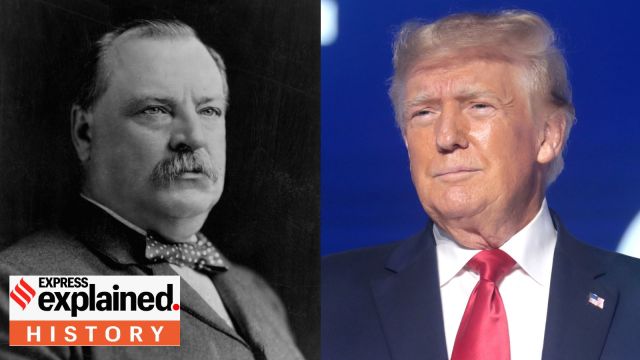In fact, the only other time a sitting president failed to get re-elected and won the next election was more than a century ago — when Democrat Grover Cleveland, the President between 1885 and 1889, won elections and again served between 1893 and 1897. Here is his story.

Who was Grover Cleveland?
Cleveland was born in New Jersey in 1837. He worked as a lawyer in Buffalo, New York, and gained political prominence in his mid-40s with his election as the city’s mayor in 1881. Later, he became the Governor of New York State.
Story continues below this ad
Daniel Klinghard, a professor of political science at the College of the Holy Cross, told the Associated Press that Cleveland was then “viewed as the epitome of responsibility and stability.” But his campaign was not free from controversy.
While his opponent and Republican nominee James Blaine was reportedly involved in a bribery scandal, Cleveland was accused of sexually assaulting a woman and abandoning their child. Given the social norms of the time, there was significant outrage over Cleveland (then a bachelor) fathering a child out of wedlock.
Around a decade before the presidential campaign, he met widow Maria Halpin, who claimed he forced himself on her. Halpin was later admitted to a local asylum for the insane and had their child taken away from her.
Cleveland admitted that he may have fathered the child but said it “certainly shouldn’t preclude him from serving as president,” according to History.com. Neither did the voters see it as a disqualifying factor, with Cleveland winning the election in 1885. Smithsonian Magazine said his opponents tried to popularise a chant on the incident: “Ma, ma, where’s my Pa?” After he won, Democrats answered it with: “Gone to the White House, ha ha ha!”
Story continues below this ad
Why Cleveland lost the re-election and how he returned
Cleveland attempted to reform the administrative system, as he did when he was Governor. He also opposed increased government spending on workers’ issues — more in line with the Republican Party’s stated ideology today. The White House website states: “Vetoing a bill to appropriate $10,000 to distribute seed grain among drought-stricken farmers in Texas, he (Cleveland) wrote: “Federal aid in such cases encourages the expectation of paternal care on the part of the Government and weakens the sturdiness of our national character…”
Such policies ended up costing him the re-election bid. Issues in how his campaign was run also played a role, although he received more votes than his Republican opponent Benjamin Harrison (what is called “the popular vote”). Harrison, however, won the electoral college.
Cleveland left the White House and spent some time working as a lawyer., but soon began voicing public criticisms of the government. In particular, he opposed the high tariffs imposed by President Harrison. The economic issue also resonated with voters. Klinghard told AP, “That model of a president being a vocal, clear spokesperson for a policy that animated the party” was emulated by future presidents. It also allowed him to remain in the public eye.
“This is a point at which the modern notion of the national party really came together. Cleveland had a group of skilled political operatives, very wealthy folks, who saw themselves benefiting from free trade,” Klinghard said. “And they spent a lot of time sort of keeping Cleveland’s name in front of the electorate, sort of very much as Trump’s allies have done, sort of dismissing anybody else as a challenge — as a rival,” he added.
Story continues below this ad
The political system was also less organised then, with no primaries (held today for a party to select the presidential nominee among various contenders). This allowed him to rise within the system again with greater ease. Ultimately, Cleveland won the Electoral College and the popular vote and became president again, taking the oath again at the age of 55.
According to NPR, several attempts have been made since then — President Martin Van Buren, who served from 1837 to 1841, tried running as a third-party candidate in 1848; Millard Fillmore, who served from 1850 to 1853, ran again in 1856; Theodore Roosevelt, who left the White House in 1909, ran unsuccessfully for a third term in 1912 (before two-term limits became the law). Only Trump has been successful.








































